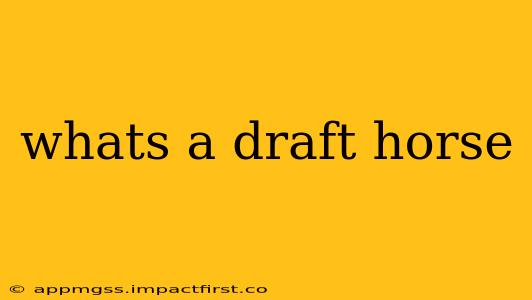What's a Draft Horse? A Deep Dive into the Gentle Giants of the Equine World
Draft horses, also known as draught horses, are a breed of horse specifically bred for their immense strength and power. These majestic animals aren't your typical riding horses; they were, and in some cases still are, invaluable workhorses, playing a crucial role in agriculture and transportation throughout history. Their sheer size and muscular build are testaments to their incredible ability to pull heavy loads, making them indispensable in various demanding tasks. Let's delve deeper into what makes these gentle giants so unique.
What are the characteristics of a draft horse?
Draft horses are easily distinguished by their size, strength, and specific physical characteristics. They are significantly larger than lighter breeds, typically standing between 16 and 19 hands high (64 to 76 inches at the withers). Their bodies are heavily muscled, especially in the shoulders, back, and hindquarters, providing the necessary power for pulling heavy weights. They often possess a broad chest, strong legs, and large, powerful hooves. Their coats can range in color, with common varieties including bay, brown, black, and gray. Their temperament is generally calm, docile, and patient, making them relatively easy to handle despite their size.
What breeds of horses are considered draft horses?
Several breeds fall under the umbrella of "draft horse." Some of the most well-known include:
- Belgian Draft Horse: Known for its muscular build and reddish-brown coat, the Belgian Draft Horse is one of the most popular draft breeds worldwide.
- Clydesdale: Recognizable by their feathered legs and impressive stature, Clydesdales are often associated with their use in advertising and show.
- Percheron: These horses are known for their elegant appearance and stamina, with a coat that can be either gray or black.
- Shire Horse: The Shire Horse is one of the largest horse breeds, characterized by its substantial size and often a bay coat.
- Suffolk Punch: This rare breed is known for its distinctive chestnut coat and incredible pulling power.
What is the difference between a draft horse and a light horse?
The key difference lies in their size and intended purpose. Draft horses are significantly larger and heavier than light horses, built for heavy work and pulling. Light horses, on the other hand, are smaller and more agile, often used for riding, driving lighter vehicles, or other tasks requiring speed and maneuverability. Think of it this way: a draft horse is built for power, while a light horse is built for speed and agility.
What are draft horses used for today?
While the widespread use of tractors and other machinery has reduced their role in agriculture, draft horses still hold a place in various settings:
- Agricultural work: Some farmers still utilize draft horses for tasks like plowing fields, especially in areas where tractors are impractical.
- Logging: Their strength makes them valuable in specialized logging operations.
- Recreation: Draft horses are increasingly popular for recreational activities like driving, showing, and therapeutic riding programs.
- Pulling competitions: Their power is showcased in competitions like horse pulling contests.
Are draft horses good for riding?
While draft horses are not typically used for riding in the same way as lighter breeds, some individuals do ride them. However, their size and build make them less suitable for many riding disciplines. They are typically more comfortable performing slower-paced work, and their size may present challenges for less experienced riders.
How much does a draft horse weigh?
The weight of a draft horse varies significantly depending on the breed and individual, but they can weigh anywhere from 1,800 to 2,400 pounds (816 to 1089 kg) or even more.
How much does a draft horse cost?
The cost of a draft horse varies widely depending on several factors, including breed, age, training, and lineage. Prices can range from several thousand dollars to tens of thousands of dollars.
In conclusion, draft horses represent a fascinating intersection of history, power, and gentle nature. These magnificent animals continue to hold a special place in our hearts and in specific sectors, proving their enduring strength and value.
